PIB Headquarters
GST Cuts Empower Farmers, Artisans & MSMEs in Arunachal Pradesh
प्रविष्टि तिथि:
09 OCT 2025 12:15PM by PIB Delhi
Key Takeaways
- In Arunachal Pradesh, GST rates on key agricultural, horticultural, processed, and artisanal products have fallen from 12–18% to 5%, reducing prices by 6–11% and directly improving producer margins.
- With over 70% of Arunachal Pradesh’s population dependent on farming, GST cuts make products like Arunachal Orange, kiwi, and Adi Kekir Ginger more affordable and competitive domestically and globally.
- Biscuits, with GST cut from 18% to 5% become ~11% cheaper, while pickles are ~7% more affordable.
|
Introduction
The recent GST reforms substantially reduce the tax burden on essential goods and services, making them more affordable for consumers. By lowering costs across key sectors, these reforms aim to boost consumer demand, enhance the competitiveness of domestic industries, and create a ripple effect that drives overall economic growth. Arunachal Pradesh, India’s remotest north-eastern state also stands to benefit from these reforms.
The tax cuts support Arunachal Pradesh’s development priorities- strengthening its agricultural base and advancing socio-economic progress. With over 70% of its population dependent on agriculture, the state witnesses strong demand for its traditional handicrafts both domestically and globally. Other prominent sectors include cane and bamboo, wood carving, and horticulture, to name a few. By making these key sectors more cost-competitive, the GST reforms are poised to boost demand, widen market access, support exports, and accelerate Arunachal Pradesh’s overall economic growth.
Agriculture & Horticulture (Fruits & Crops)
Arunachal Pradesh, the largest state in India’s Northeast, is predominantly agrarian and richly endowed with natural resources and diverse agro-climatic zones. Agriculture remains the cornerstone of the state’s socio-economic development strategies. The recent GST reduction on key agricultural and horticultural products- majorly from 12% to 5% makes the state’s produce more affordable and competitive in both domestic and global markets. This tax relief not only reduces production and marketing costs but also stimulates demand, boosts sales, and enhances export potential- directly benefiting the farming community that forms the backbone of Arunachal Pradesh’s economy.
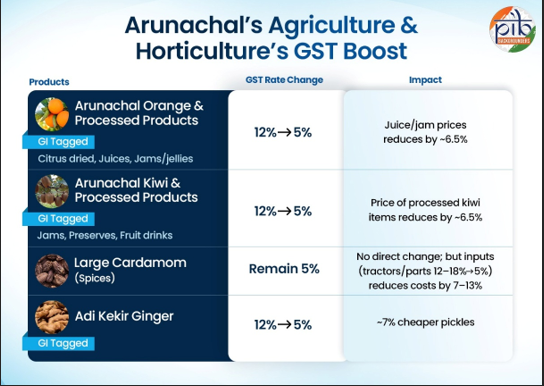
Arunachal Orange & Processed Products
In Arunachal Pradesh, regions like Wakro (Lohit), Dambuk (Lower Dibang), East Siang, and Tawang produce the GI-tagged Arunachal Orange, known for its distinct sweet-sour taste from high TSS and acidity- and its processed forms such as dried citrus, juices, and jams/jellies. Around 30,000–40,000 households depend on this sector across 15,971 hectares of orchards, and produced 62,633 million tonnes (MT) in 2022–23 (farm-gate value: ~₹501 crore). Despite challenges like pest attacks, labor shortages, and limited cold storage, it remains the key livelihood for thousands of tribal families.
Exports began with 1 MT to Dubai in 2018, and APEDA (Agricultural & Processed Food Products Export Development Authority) promotes exports to the UAE, Bhutan, and ASEAN nations (Association of Southeast Asian Nations, current members being Brunei, Cambodia, Indonesia, Laos, Malaysia, Myanmar, the Philippines, Singapore, Thailand, and Vietnam).
The GST cut from 12% to 5% on juices and jams makes prices ~6.5% lower (₹105 instead of ₹112 for a ₹100 juice), supporting processors, reducing post-harvest losses, and boosting competitiveness.
Arunachal Kiwi & Processed Products
Arunachal Pradesh is India’s largest kiwi producer with over 50% of national output. It produced 4,492 MT in 2022–23 (farm value: ₹67.4 crore). The state is home to India’s first certified organic, GI-tagged kiwi, cultivated mainly across Ziro Valley (Lower Subansiri), West Kameng, Tawang, Si-Yomi, Kamle, and Papum Pare. Kiwi and processed kiwi products such as jams, preserves, and fruit drinks are sourced directly from farmers by Naara Aaba winery. Smallholder tribal farmers drive production, and are allied to the state’s Kiwi Mission 2025. Notably, Arunachal Pradesh aims to expand cultivation across 13 districts. The sector provides livelihood to thousands of households, while APEDA’s successful market tests in Dubai signal strong export potential.
The recent GST reduction from 12% to 5% on kiwi and processed products has cut prices by ~6.5%, boosting MSME participation, supporting value addition, and reinforcing the objectives of the Kiwi Mission 2025.
Large Cardamom
Large cardamom, a leading spice from the Eastern Himalayas, serves as a high-value cash crop and an economic backbone of the Mishmi tribes in Arunachal Pradesh. Cultivated across Anjaw (the largest producer), East and Upper Siang, Subansiri, Tirap, and Changlang districts, it provides the primary livelihood for thousands of farmers. In 2021–22, the state produced 1,695 MT of large cardamom valued at ~₹211–237 crore. India remains a key global exporter, with international prices ranging from USD 10–13 per kg.
While GST on spices continues to be 5%, the recent reduction in GST rates on agricultural inputs such as tractors and parts- from 12-18% to 5%, lowers input costs by 7-13%, thereby enhancing profitability for large cardamom growers.
Adi Kekir Ginger
The Adi Kekir Ginger, a GI-tagged variety of ginger from Arunachal Pradesh, is prized for its distinctive size and aroma. Cultivated primarily by Adi farmers across East and Upper Siang districts, it sustains smallholder families and self-help groups (SHGs) engaged in producing pickles and candies. Valued both for its premium quality and cultural significance, this local spice now holds growing export potential, strengthened by its GI recognition in 2024.
The GST rate on ginger's processed forms has been reduced from 12% to 5% under recent reforms- making pickled products around 7% cheaper and directly improving margins for SHGs and small processors.
Dairy Product- Yak Churpi (Cheese)
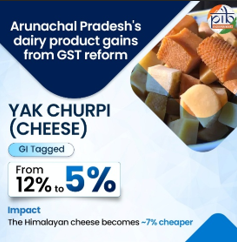
Yak Churpi, a GI-tagged Himalayan cheese, is traditionally produced by the yak-herding Brokpa and Monpa communities across Tawang and West Kameng districts of Arunachal Pradesh. ~1,200 yak herders depend on this dairy production as their primary source of income, with the probiotic-rich cheese serving as both a local staple and a popular tourist snack.
The reduction of GST from 12% to 5% makes Yak Churpi ~7% cheaper, helping boost demand and supporting the livelihoods of local herders.
Textiles & Handicrafts
Arunachal Pradesh is home to over 20 major tribes, each known for unique traditions, craftsmanship, and artistic heritage. Drawing from the region’s abundant natural resources, artisans have long created everyday essentials- from woven textiles to bamboo and cane crafts, baskets, carpets and furniture. Among its celebrated handlooms are the Mishmi and Sherdukpen shawls. Equally notable are Arunachal Pradesh’s carpets, which have earned national and international recognition for their quality and craftsmanship.
Idu Mishmi Textiles
Women of the Idu Mishmi tribe preserve their rich weaving heritage through the production of Idu Mishmi Textiles, known for geometric patterns imbued with mythological symbolism, primarily across Dibang Valley and Lower Dibang. The craft provides livelihoods for ~2,000–3,000 artisans out of a total of ~94,000 weavers in Arunachal Pradesh. These textiles are sold at fairs and emporia but face competition from machine-made alternatives. Although current exports are minimal, the GI recognition (2014) offers potential to develop future markets.
The recent GST reduction from 12% to 5% is a significant boost. On a ₹8,000 shawl, GST decreases by ₹560- enhancing profitability for the artisans and supporting the sustainability of this traditional craft.
Handmade Carpets (Monpa/Sherdukpen/Tibetan)
Handmade carpets in Arunachal Pradesh are crafted by Buddhist communities (Monpa and Sherdukpen) and Tibetan refugees across Tawang, West Kameng, Changlang, and Upper Siang. The industry provides employment to ~101 artisans in the Lahou cluster and hundreds more in other centers. These carpets, often sold in emporia and tourist markets, feature traditional designs, including Buddhist motifs, which hold significant export potential within India’s large carpet market. The main types of these functional, traditional carpets are Khatan and Maksu-Maktan.
The recent GST reforms have an encouraging impact on this sector- on a ₹20,000 carpet, the tax reduction of ₹1,400 directly boosts women artisans’ income and supports the sustainability of this heritage craft.
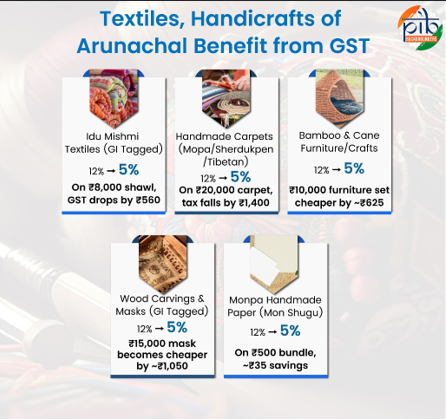
Bamboo & Cane Furniture/Crafts
Bamboo, cane furniture and crafts in Arunachal Pradesh are primarily produced by male artisans from major tribal communities, including the Adis, Apatanis, Nyishis, Mishmis, Noctes, and Wanchos. Tens of thousands of artisans create a wide range of items for homes and markets. A notable example is the 500-ft Adi bamboo bridge in the Lower Dibang Valley. The state benefits from abundant bamboo resources, with a stock of 8,824 million culms. India’s has been exporting bamboo furniture and there is strong potential for Arunachal’s crafted designs in both domestic and international markets.
The recent GST reduction from 12% to 5% significantly lowers costs for buyers and boosts competitiveness. For instance, a ₹10,000 furniture set costs ~₹625 less in tax, making products more affordable, stimulating demand, and directly benefiting the artisans’ income while encouraging the growth of MSMEs in this traditional craft sector.
Wood Carvings & Masks
In Tawang and West Kameng (Monpa and Sherdukpen tribes) and Tirap and Longding (Wancho tribe), male artisans craft wooden carvings, including ritual items, masks, and pipes. Wancho carvings are linked to head-hunting traditions, while Monpa masks are integral to Buddhist rituals. The sector employs a few thousand artisans, many of whom receive training and support from KVIC (Khadi & Village Industries Commission). In the souvenir and tourism markets, masks sell for ₹2,100 - ₹2,500, with antique pieces fetching higher prices. While export volumes are currently limited, tribal art holds promising potential in international markets too.
The recent GST reduction from 12% to 5% further supports the industry- on a ₹15,000 mask, tax savings of ~₹1,050 make products more affordable, boosting tourist sales and improving artisan incomes.
Monpa Handmade Paper (Mon Shugu)
Monpa artisans from Tawang produce Monpa handmade paper, an ancient bark paper revived with support from KVIC to preserve Buddhist scriptural heritage. The paper is sold to monasteries and tourists at ~₹50 per sheet. Currently, 14 artisans- 12 of whom are women, are engaged in this craft, with ongoing efforts to train local youth. Notably, there is growing niche demand for eco-friendly paper in international markets.
The recent GST reduction from 12% to 5% further enhances competitiveness- on a ₹500 bundle, tax savings of ~₹35 make the product more affordable and marketable.
Processed Foods & MSMEs
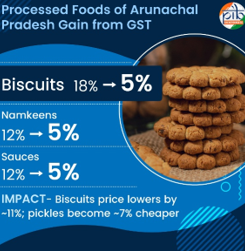
Women’s SHGs and youth-led startups in Arunachal Pradesh are actively engaged in food processing, with key hubs in Itanagar, Pasighat, Anjaw, and Namsai producing items such as biscuits, namkeens, and sauces. The sector comprises 632 registered MSMEs employing 4,591 people, alongside a broader informal workforce of 41,069. The industry also leverages from organic farm produce, supplying products to local towns and fairs, and contributes 22.6% to the state’s Gross State Value Added (GSVA). While export volumes remain limited, there is growing potential in fruit preserves and pickles.
The recent GST reduction strengthens competitiveness- biscuits, with GST cut from 18% to 5% become ~11% cheaper, while pickles are ~7% more affordable- supporting both producers and consumers.
Wood Industry (Plywood, Veneer)
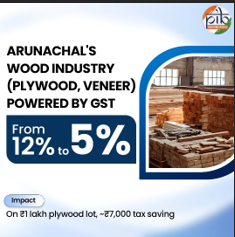
Arunachal Pradesh has a significant forest-based industry, central to the state’s economy as 80% of the state comes under forest cover. Timber is a key natural resource; and the wood industry, focused mainly on plywood and veneer, operates across forest-rich districts. The industry provides employment in sawmills and plywood mills, and supplies products to the construction and furniture markets.
For plywood and veneer, the GST reduction from 12% to 5% offers substantial relief- on a ₹1 lakh plywood lot, tax savings amount to ~₹7,000- though sustainable forestry management remains essential to ensure long-term viability.
Conclusion
The GST reforms, reducing rates from 12–18% to 5%, provide a major boost to Arunachal Pradesh’s economy. By lowering taxes on agriculture, horticulture, processed foods, handicrafts, textiles, bamboo and cane furniture, and wood-based industries, these reforms make products more affordable and improve producer margins.
Cost savings- ranging from 6-11% on processed foods to ₹560-₹7,000 on handicrafts, carpets, and plywood- enhance competitiveness, stimulate demand, support MSMEs, and benefit tribal artisans. The reforms also strengthen domestic and export market access, promote traditional and GI-tagged products, and drive sustainable growth, employment, and inclusive development across the state.
References
arunachalpradesh.gov.in
https://arunachalpradesh.gov.in/
agri.arunachal.gov.in
https://agri.arunachal.gov.in/
IBEF
https://ibef.org/industry/arunachal-pradesh-presentation
ASEAN.org
https://asean.org/member-states/
mygov.in
https://blog.mygov.in/the-role-of-traditional-craftsmanship-in-the-tourism-industry-of-arunachal-pradesh/
Click here for pdf file.
***
SK/M
(रिलीज़ आईडी: 2176656)
आगंतुक पटल : 776